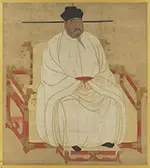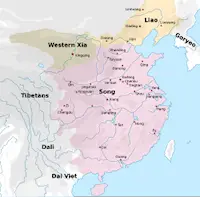China's Song Dynasty
The Song Dynasty put an end to the chaos of the Period of the Five Dynasties and Ten Kingdoms by conquering the last of those dynasties and kingdoms. Historians date the founding of the Song Dynasty to 960, as declared by Zhao Kuangyin, who took the name Emperor Taizu. He defeated the Later Zhou forces of Guo Wei in that year, resulting in control of all of the north. (The Five Dynasties were successive; the Ten Kingdoms were, more or less, concurrent.) By that time, six of the 10 Kingdoms remained:
What remained were the Sixteen Prefectures, in the northeast; those became the Liao state. A threat to the west were the Western Xia. Song forces eventually overcame both foes in time. 
Taizu (left) was the power behind all of that consolidation. Establishing his capital at Kaifeng, in the north, he established a strong central government, peopled with civil servants who had passed rigorous entrance examinations. The emperor encouraged his people to reach new heights of advancement: in technology, in warfare, in economic success. He died in 976, before the last surrender of the last two of the Ten Kingdoms. His younger brother succeeded him and was later named Emperor Taizong; it was he who completed the reunification. Song armies, flush with success at conquering the last of the Five Dynasties and Ten Kingdoms, turned their sights to the northeast and clashed with armies of the Liao. At the Battle of Gaoliang River, near what is today Beijing, Song forces suffered their first significant defeat, falling to a relief force after besieging the city's mighty walls for three months. Because the Song capital, Kaifeng, was in the north, historians refer to the earlier part of the Song reign as Northern Song. It was the Northern Song who found themselves on the defensive in the years surrounding the beginning of the 11th Century, as emboldened Liao forces marched southward, seizing land as they went. The 1005 Shanyuan Treaty, requiring Song to pay tribute to Liao, ended this struggle, for a time. Rejuvenated Song armies stormed northwestward and, under the leadership of the scientist-general Shen Kuo, scored a handful of victories over the Western Xia. As with so many military campaigns, however, the Song armies found themselves bogged down and eventually lost the territory that they had gained. Song forces had similar frustrations in fighting in the south, targeting possessions in what is now Vietnam. Back-and-forth territorial seizures came to an end in 1085, with both sides, having encountered heavy losses, agreeing to a truce. In 1115, the Liao found themselves victims of an uprising, by a subject tribe known as the Jurchen. This people threw off their regents and formed their own dynasty, Jin. Song Emperor Huizong then formed an alliance with the Jin and together, they overthrew the Liao, in 1125. Not content with that victory, Jin forces threw off their alliance with the Song and declared war on them instead. The Jin-Song Wars resulted in embarrassing defeat for the weakened Song, including the capture by Jin forces of the Emperor Qingzong, former Emperor Huizong, and many of the roayl court, in what came to be known as the Jingkang Incident. Another strongman stepped forward and rallied the Song. He called himself Emperor Gaozong and established a new capital, Lin'an, in the south. Thus began the Southern Song Dynasty. 
The Jin-Song Wars continued. To bolster their defenses, Song forces in 1132 created the civilization's first permanent navy, with headquarters at Dinghai. Song rulers ordered built paddle-wheel boats, which served as warships and also as escorts for an expanding merchant fleet, which sailed as far west as Arabia, delivering Chinese copper, porcelain, silk, tea, and other goods to the world. Guiding these ships on their journeys was an improved form of the compass, which scientists in Han times had invented. Song forces also deployed the relatively new weapon gunpowder to devastating effect. In two battles on the Yangtze in 1161, the heavily outnumbered Song nonetheless defeated a much larger Jin force, through a combination of faster and more maneuverable ships and gunpowder bombs launched from shipboard catapults. 
Song armies employed other gunpowder-driven weapons, including the fire lance, to combat the Jin. An alliance with the relative newcomers the Mongols enabled Song forces to recapture a large amount of what the Jin had taken, including Chang'an, Kaifeng, and Luoyang. (Mongol armies had conquered the Western Xia and then forced to the Jin to submit as vassals.) The Song success made their Mongol allies suspicious, and then-Khan Mongke led his armies against their Song allies in 1259. Song forces were victorious at the Battle of Diaoyu, killing Mongke Khan in the process. A new Khan had arrived on the scene, however, and the great Kublai pushed back against Song successes, eventually conquering the Song, in 1279. Kublai Khan had declared the Yuan Dynasty in 1271; eight years later, he achieved final victory at the Battle of Yamen. The Song Dynasty was a time of great prosperity and advancement, despite the numerous battles. Kaifeng and Lin'an at their height were two of the most populous cities in the world. Tall pagodas and other buildings dotted urban landscapes in these and other cities. Advances in commerce and industrialization powered a vibrant Song economy to new heights of wealth and prosperity. Bolstering the Song economy was the advent of paper money. In the realm of agriculture, rice replaced wheat and millet as top crop. In addition, the introduction of a drought-resistant variant of rice from Vietnam enabled farmers to triple their rice yield. Many peasants had much more ownership in the land that they worked, and many farmers achieved more wealth than ever before. Powering much of this agricultural prosperity was an advanced system of canals and irrigation. Song rulers streamlined the use of and preference for the civil service examinations stratified by their Tang predecessors. Social welfare initiatives such as public medical clinics and retirement homes found favor. As well, Song rulers actively encouraged and provided for a far-flung postal system and a dynamic education system that provided instruction for women as well as men. Song scientists increased their knowledge and understanding in engineering, mathematics, and technology. Among the advancements were the advent of movable type printing, an upgrade to wood block printing, and the use of topographic representations and a standard scale of distance on maps. One of the most famous scientists of this era was Shen Kuo, whose Dream Pool Essays touched on astronomy, magnetism, and a host of other fields of science. 
Gunpowder was most famously used in weapons during the Song Dynasty, although many workers used it in mining as well. Song armies used it in landmines against the invading Mongols. Song society enjoyed a vibrant cultural aspect. Larger cities built opera houses. Artists gravitated more toward landscape painting, and some women became famous painters. During this same period grew a practice that proved exceedingly painful to women and continued for centuries. Starting with the upper classes but eventually extending to the lower classes, family authority figures dictated that the feet of girls be broken at a young age and then bound. |
|
Social Studies for Kids
copyright 2002–2024
David White



 The Jingnan, a small kingdom that maintained good relations with neighbors, fell to Song armies in 963.
The Jingnan, a small kingdom that maintained good relations with neighbors, fell to Song armies in 963.
